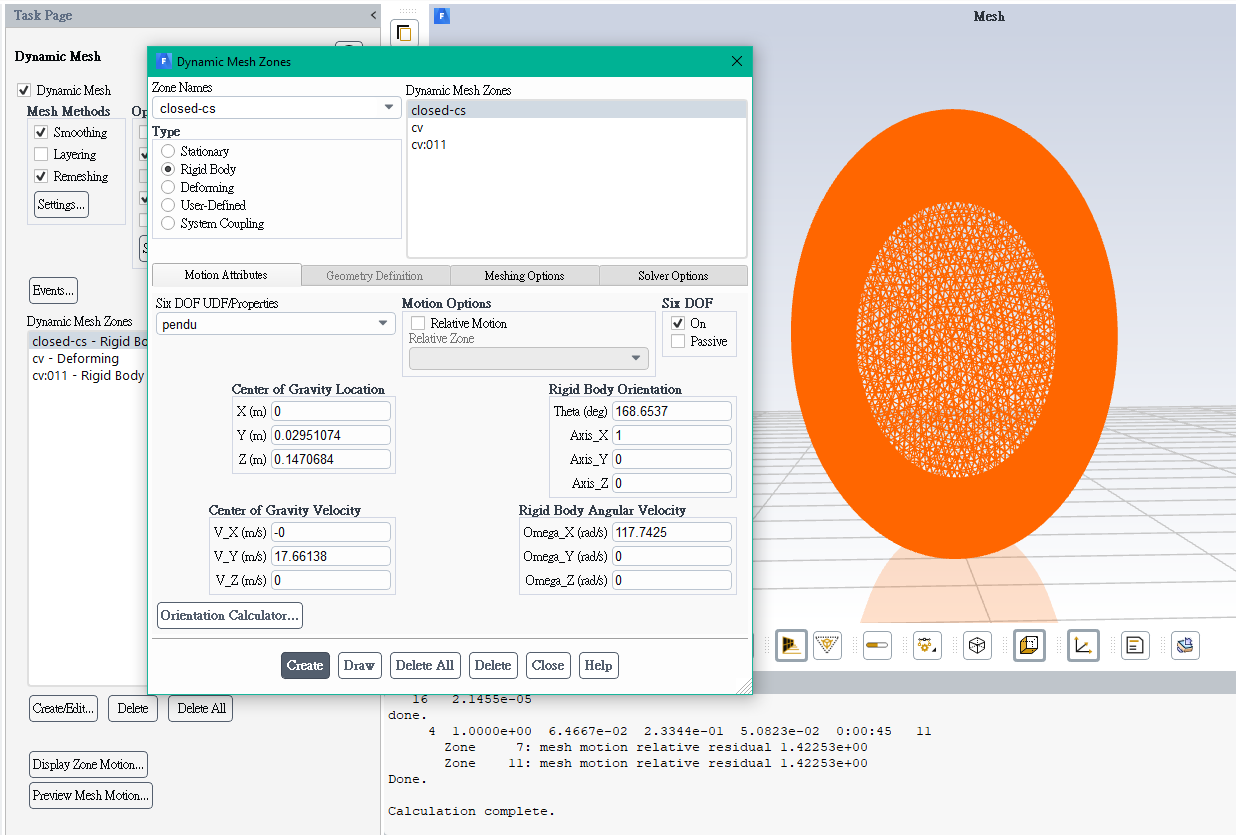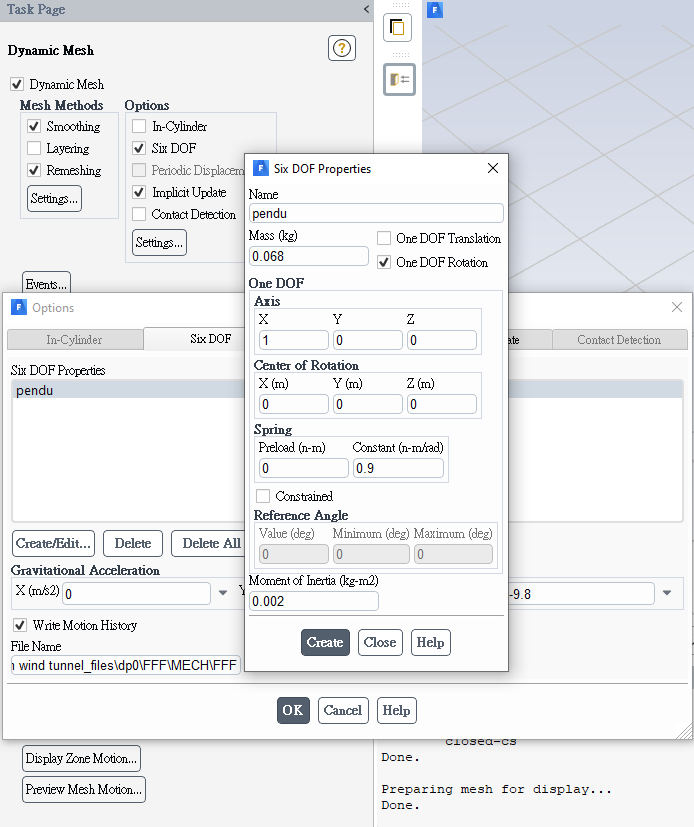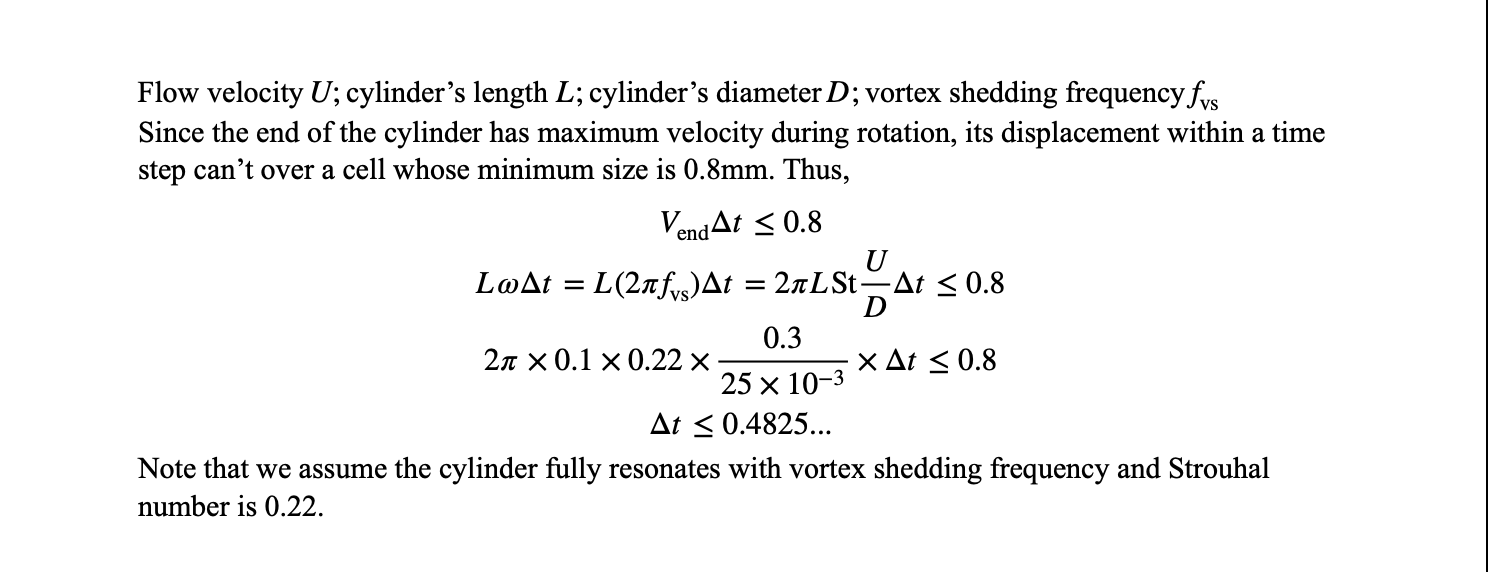TAGGED: fluent, moment-of-inertia, six-dof-solver
-
-
February 8, 2023 at 7:03 pm
Milne Ando
SubscriberG'day,
I want to make the solid geometry swing as a pendulum (rotating about the x-axis), and the magnitude of its moment of inertia is needed. Then I checked the user guide, and it says:
"Note that the inertia tensor components are defined relative to the Center of Gravity and Rigid Body Orientation settings defined in the Dynamic Mesh Zones Dialog Box (p. 3687)."
I don't understand what it means by "relative to the Centre of Gravity". Does it mean "parallel axis theorem"? Does it need the moment of inertia about the axis passing through its centre of mass? Or it needs the moment of inertia about the rotating axis (here indicating the x-axis)?
Hope someone can help me out, please. Thanks a lot.
-
February 9, 2023 at 3:07 pm
Federico
Ansys EmployeeHello Milne,
since your pendulum undergoes 1DOF rotation about the X-axis, you will need to enter the Ixx moment of inertia passing through the center of mass. Specifying the center of rotation and axis in the 6-DOF Properties dialog box, and the center of gravity location in the Dynamic Mesh Zones dialog box, Fluent will compute the correct moment of inertia during calculation.
I hope this helps.
-
February 9, 2023 at 4:12 pm
Milne Ando
SubscriberHello sir,
Well I've done sevaral tests and it always turned out to be strange; if I entered the moment of inertia passing through its CM, the console window would keep showing "6DOF angular solver has not converged ". But if I entered the moment of inertia about the x-axis (of global coordinates system), it wouldn't diverge in the beginning and could calculate through about 16 seconds (then negative cell volume occured). I just can't figure out what's wrong with my settings...

-
-
February 9, 2023 at 5:11 pm
Federico
Ansys EmployeeThe message "6DOF angular solver has not converged" means that you should either correct the "Implicit Update" settings or time step size and number of iterations per time step.
In the "Implicit Update" panel, enter the convergence criterion for the 6DOF solver (default 1e-3). If this is not achieved within a time step, reduce the update interval, calculate more iterations per time step, or reduce the time step size.I hope this helps
-
February 10, 2023 at 5:28 am
Milne Ando
Subscriber-
February 14, 2023 at 1:37 pm
Federico
Ansys EmployeeHello Milne,
your approach is correct, but are the units right? It seems to me that the LHS is in meters and RHS is in mm. Otherwise, your smallest cell is larger than the length of the cylinder.
If that's correct, than your time step would need to be reduced by a factor of 1000.
Federico
-
February 18, 2023 at 8:58 am
Milne Ando
SubscriberYes!
I didn't notice that unit was wrong. Thank you so much!
After correcting time step size, it's now around 0.00048 second. That's really small! So I need to turn to supercomputer' aid. I'll update the result in the near future.
Milne
-
-
February 10, 2023 at 8:25 pm
Milne Ando
SubscriberHello sir,
I found that once 6DOF solver can't converge (always), the cylinder would rotate almost 180º(as the pic shows:Theta(deg)) within the first time step, which is unreasonable. Plus, the circular cylinder deformed to a elliptic cylinder although it's assigned to Rigid body. Is that possible we misunderstand the statement in user guide? I've checked the theory guide, I'm sure that in six DOF properties panel, that 6 inertia tensor values are defined relative to its CM/CG. But when one DOF rotation box is checked, maybe moment of inertia isn't relative to its CM/CG? Implicit update interval is always set to 1. I've tried hard but failed to find out the bug...

-
February 14, 2023 at 1:42 pm
Federico
Ansys EmployeeI would correct the time step first, as per my last reply. Once that is fixed, if your motion still shows errors, perhaps you are right and you might want to try what you are suggesting, with moment of inertia relative to rotation axis. If you do, please update me on this forum, I'm curious to see what you find!
Bests,
Federico
-
March 5, 2023 at 10:36 am
Milne Ando
SubscriberHi,
I think I've figured out the reason. I cheked the codes and found the value of Izz was filled in my solid body's moment of inertia. So yes, that field should be filled in the moment of inertia relative to its CG. But!! This field seems only set for Izz, so if I want to assign a value to Ixx or Iyy (my axis of rotation), I need to make the z-axis of the global coordinate system lie along the axis of rotation. In other words, I initially set a value for Ixx, but the programme gave this value to Izz, 'cause I didn't know it worked in that way. I think this was the main problem that caused the calculation diverged at early iterations and strange phenomenon.
-
-
-
April 12, 2023 at 6:30 pm
Alberto
SubscriberHi, I have the same problem, but my geometry is complex shaped without any symmetry axis, so I'm expecting a non diagonal symmetric inertia tensor (6 dof) for my 3D body. SpaceClaim measure the area moment [m^5] of the body but along the principal axis of inertia, I multiply this tensor (diagonal) with the density [kg / m^3] and I find the inertia tensor in [kg m^2]. I'll put this tensor inside the properties box, the center of gravity and i have no idea on how to compute the "rigid body orientation" .
Simulation goes, fluent solver converges in few iteration, the body falls inside the cylinder with both rotation and traslation . But why i'm still having the message "six dof angular solver do not converge".
Any suggestion on how to compute correctly this inertia tensor ?
-
- The topic ‘In Six DOF properties, which value of moment of inertia should I enter?’ is closed to new replies.



-
3632
-
1313
-
1142
-
1068
-
1008

© 2025 Copyright ANSYS, Inc. All rights reserved.









